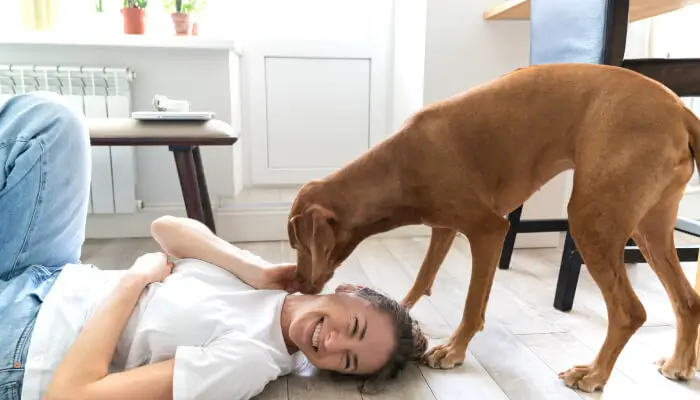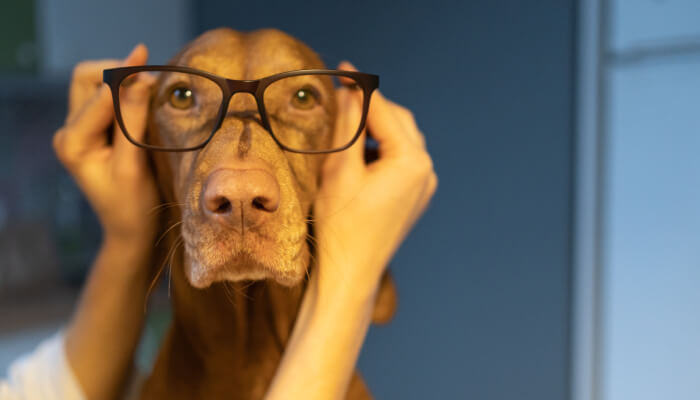As a Vizsla owner, you may have noticed that their fur color changes over time. Most often, the change is from black to brown with some white or gray mixed in. But sometimes, they can go from being mainly black to all brown or vice versa. Usually, the owners believe that Vizslas fur will get darker as they grow older.
So, do Vizslas’ fur get darker as they grow older? The short answer is yes. As Vizslas get older, their fur will darken in color until it reaches its natural shade for that dog’s age and genetics.
However, several factors go into determining the shade of color of your dog’s coat. Just like with humans, genetics play a role in their fur later on, but it also depends on other things such as diet and exposure to sunlight.
In the next part of this article, we will go over some factors that determine the shade of color for a Vizsla’s fur.
Do Vizslas Fur Get Darker As They Grow Old?
No, Vizslas fur does not get darker as they grow old. They can still change color with age, but the coat will typically stay in a lighter shade (brown or gray). But keep in mind that this is just one of many factors that determine the color of their fur.
As Vizsla ages, their fur will start to lighten from black to brown. The color change may happen gradually or quickly, depending on your dog’s genetics and health condition.
When Do Vizslas Fur Change Color?
Vizslas fur can change color as they age, but not necessarily because of their age. Instead, the different colors in Vizslas are due to genetic factors such as coat pattern and one or both parents’ coats. They are also a result of health conditions like flea allergies that cause a dog’s body to react to the fleas as an environmental allergen.
At What Age Do Vizslas’ Coats Starts To Change Color?
Vizsla coats will typically stay the same for the first four years or so. When they are about three or four years old, their jacket will start to lighten from black to brown. The color change may happen gradually or quickly, depending on your dog’s fur pattern and environment.
The Vizslas coat can also darken at around five years, making them nearer to the original black color. But, again, it is because of the changes in the dog’s hormones as they mature and grow older.
Factors That Determine The Shade Of Color Of Vizsla’s Fur:
The shade of color in a Vizslas fur coat depends on many factors, including the genetics of both parents and their health condition(s).
Let’s talk about all the factors separately:
Coat pattern:
Vizslas can have coat patterns like sable, brindle, or solid colors that will determine the shade of their fur color.
Example: Two black parents with a patterned coat (like brindle) could produce all brown offspring.
Genetics of parents :
Most Vizslas have black and white as their base colors. But if one or both parents are brown, gray, or some other color-variant of a similar shade, then the offspring maybe that same color instead.
Example: Two sable parents can produce all-brown puppies.
Health conditions:
A dog’s fur color could change due to some health condition they are dealing with. It can be a sign of an illness or injury that needs attention from your veterinarian.
Example: Flea allergies may cause the coat to turn brown rather than black on constant exposure to fleas and their saliva, which triggers a body’s reaction.
Natural Aging Process:
They undergo various changes in the different growth stages of Vizsla. As they age, Vizslas fur can change from black to brown. But the color will typically stay lighter (brown or gray).
When Should I Be Concerned About My Vizsla’s Fur Changing Color?
If your Vizsla’s fur changes color suddenly, it could be a sign of illness or injury. If you suspect that something is wrong with them and their fur color change has been sudden, visit your veterinarian.
Moreover, older Vizsla needs more care and continuous supervision. The older your pet gets, the more prone they get to various health issues. So, you must be very attentive if you have a Vizsla older than 5-6 years old.
What Diseases Can Change The Color Of Vizsla’s Fur? Sudden Change In Color Of Vizsla’s Fur
The sudden change in the color of Vizslas fur can be due to some diseases, including:
Flea Allergy:
Most owners often assume that many Vizsla’s have a genetic defect in their immune system which causes them to react to fleas as an environmental allergen. The body responds by producing high levels of histamines, resulting in itching and scratching (which can lead to hair loss), redness and inflammation.
Tumors:
Tumors may cause a change in the color of Vizslas because they can affect areas where hair grows, such as skin and nails (due to exposure). It could also be due to melanoma or other cancers that produce pigmentation problems.
Injury, Burns, And Other Medical Conditions:
Injuries might lead to hair loss or a color change. Burns and other medical conditions might also cause fur changes, affecting areas where hair grows, such as skin, nails, and eyes.
Autoimmune Disorder (e.g., Addison’s)
Addison’s disease, which is a form of autoimmune thyroiditis and affects the adrenal glands that produce hormones for stress and appetite control and other functions like sugar regulation and salt balance, can cause hair to change color.
How To Prevent The Vizsla’s Color Change?
You can prevent the fur change in color by avoiding or removing any possible health conditions and diseases that could lead to it.
You cannot avoid natural factors, but you can for sure deal with them. For example, if your dog has flea allergies and you notice that their fur is changing color because of it, then consult a veterinarian about the best treatment for them.
Treatment:
The treatments that you can use to prevent the color change of Vizsla’s fur are:
Flea Allergy Treatment
If Vizsla’s coat changes color due to an allergy to fleas, consult a veterinarian about the best treatment for them.
Tumor Treatment
If your dog’s coat color is changing due to tumors or other cancers that produce pigmentation problems, consult with your veterinarian on how to treat it. They will probably recommend surgery as soon as possible if there are any signs of melanoma.
Injury Treatment
If the Vizslas changed color due to an injury, consult with your veterinarian about how best to treat it. They may prescribe you a medication or recommend surgery if there is any possibility of infection.
Burns (e.g., chemical) Treatment
Sometimes burns can cause hair loss and change fur color. Consult with your veterinarian to find out the best way of treating burns if this is the case for you.
Addison’s Disease Treatment
If a dog’s fur changes due to Addison’s disease, consult with your veterinarian about how best to treat it and what medications or supplements they should take (or not take).
Conclusion
In conclusion, it is difficult to say precisely when a Vizsla will have a darker fur. However, it is typical for the color of their coat to darken as they age. In addition, the article mentions that some factors which can determine the shade of the Vizslas’ hair are how often they shed, whether or not they get sun exposure, and general health.
Remember that Vizslas are primarily hunting dogs, which means they may have darker fur because of their occupation and not necessarily due to age.



